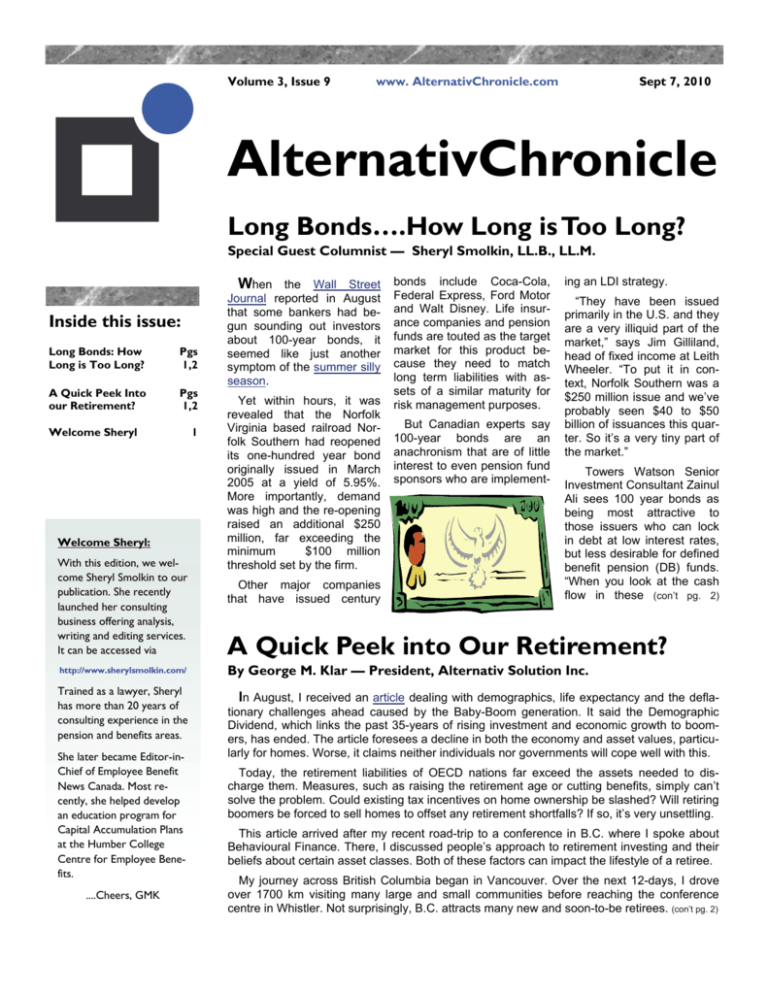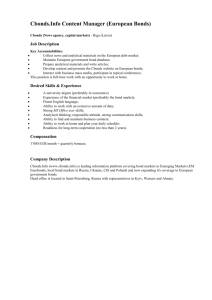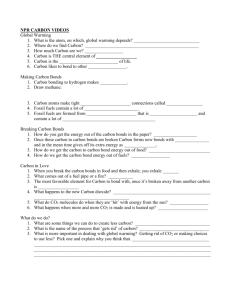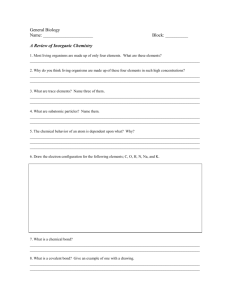
Volume 3, Issue 9
www. AlternativChronicle.com
Sept 7, 2010
AlternativChronicle
Long Bonds….How Long is Too Long?
Special Guest Columnist — Sheryl Smolkin, LL.B., LL.M.
When
Inside this issue:
Long Bonds: How
Long is Too Long?
Pgs
1,2
A Quick Peek Into
our Retirement?
Pgs
1,2
Welcome Sheryl
Welcome Sheryl:
With this edition, we welcome Sheryl Smolkin to our
publication. She recently
launched her consulting
business offering analysis,
writing and editing services.
It can be accessed via
http://www.sherylsmolkin.com/
Trained as a lawyer, Sheryl
has more than 20 years of
consulting experience in the
pension and benefits areas.
She later became Editor-inChief of Employee Benefit
News Canada. Most recently, she helped develop
an education program for
Capital Accumulation Plans
at the Humber College
Centre for Employee Benefits.
....Cheers, GMK
1
the Wall Street
Journal reported in August
that some bankers had begun sounding out investors
about 100-year bonds, it
seemed like just another
symptom of the summer silly
season.
Yet within hours, it was
revealed that the Norfolk
Virginia based railroad Norfolk Southern had reopened
its one-hundred year bond
originally issued in March
2005 at a yield of 5.95%.
More importantly, demand
was high and the re-opening
raised an additional $250
million, far exceeding the
minimum
$100 million
threshold set by the firm.
Other major companies
that have issued century
bonds include Coca-Cola,
Federal Express, Ford Motor
and Walt Disney. Life insurance companies and pension
funds are touted as the target
market for this product because they need to match
long term liabilities with assets of a similar maturity for
risk management purposes.
But Canadian experts say
100-year bonds are an
anachronism that are of little
interest to even pension fund
sponsors who are implement-
ing an LDI strategy.
“They have been issued
primarily in the U.S. and they
are a very illiquid part of the
market,” says Jim Gilliland,
head of fixed income at Leith
Wheeler. “To put it in context, Norfolk Southern was a
$250 million issue and we’ve
probably seen $40 to $50
billion of issuances this quarter. So it’s a very tiny part of
the market.”
Towers Watson Senior
Investment Consultant Zainul
Ali sees 100 year bonds as
being most attractive to
those issuers who can lock
in debt at low interest rates,
but less desirable for defined
benefit pension (DB) funds.
“When you look at the cash
flow in these (con’t pg. 2)
A Quick Peek into Our Retirement?
By George M. Klar — President, Alternativ Solution Inc.
In August, I received an article dealing with demographics, life expectancy and the deflationary challenges ahead caused by the Baby-Boom generation. It said the Demographic
Dividend, which links the past 35-years of rising investment and economic growth to boomers, has ended. The article foresees a decline in both the economy and asset values, particularly for homes. Worse, it claims neither individuals nor governments will cope well with this.
Today, the retirement liabilities of OECD nations far exceed the assets needed to discharge them. Measures, such as raising the retirement age or cutting benefits, simply can’t
solve the problem. Could existing tax incentives on home ownership be slashed? Will retiring
boomers be forced to sell homes to offset any retirement shortfalls? If so, it’s very unsettling.
This article arrived after my recent road-trip to a conference in B.C. where I spoke about
Behavioural Finance. There, I discussed people’s approach to retirement investing and their
beliefs about certain asset classes. Both of these factors can impact the lifestyle of a retiree.
My journey across British Columbia began in Vancouver. Over the next 12-days, I drove
over 1700 km visiting many large and small communities before reaching the conference
centre in Whistler. Not surprisingly, B.C. attracts many new and soon-to-be retirees. (con’t pg. 2)
century bonds, they are longer than
the cash flows you’d see in most
DB plans, so right away there is a
mismatch.”
According to Ali, when DB plans
are looking for long bonds, they are
really looking for duration.
“Duration is different from term,”
he explains. “Duration is a mathematical concept which is a formulaic
way of figuring out the price sensitivity of the bond to changes in interest
rates. A 100-year bond gives you
marginal duration advantage over a
30-year bond.”
issued the more conventional 30year bonds.
But Disney also retained an important
right to call (redeem) the bonds
130 King St. W, Ste. 1800, Toronto, ON M5X 1E3
after 30 years at a specified price of
B: (416) 567- 4464 george.klar@sympatico.ca
103.02% of face value. Thus 30
years after issuing the bonds, the
company will have the best of both
worlds. If prevailing interest rates are
them, so you may very well not have this
lower, they can call the bonds and
bond for 100 years. You have to decide
replace them with a new cheaper
as an investor if these risks – prepayment
bond issue. But if interest rates are
risk, the credit risk and term risk, are
high, the century bonds can remain
worth the premium you may get.”
outstanding and will continue to pay
What is the premium for 100 year 7.55% for another seventy years!
bonds over 30 year issues?
The longest Canadian bond that
Ali says some investment dealers are Gilliland is aware of is a 60-year Quesaying they probably would have paid 75 bec bond issued five years ago. Cenbasis points more for a 100-year bond tury bonds have not been issued in
than for a 30 year Norfolk Southern bond, Canada to date and he believes Caassuming they had issued such a bond.
nadian pension funds have had little
A University of Washington School of interest in the few U.S. 100-year
Business case study on Disney’s century bonds that have been marketed.
And in an era of unprecedented
economic and technological change
credit risk is an important consideration. “The U.S. railroad bonds are
longer than we need (60 years is
enough) and being corporate it is
tough to assess credit quality over
such long periods,” says Tony Williams, president of PBI Actuarial bond, dubbed the “Sleeping Beauty
bonds”, reports the issue was priced on
Consultants Ltd.
July 20, 1993 to yield 0.95% (95 basis
Prepayment risk is another thing
points) over the benchmark 30-year
to consider, says Ali. “A lot of these
Treasury Bond, which at the time, yieldissuers who are going to issue 100
ing approximately 6.60%. Analysts estiyear bonds are probably going to
mated that this was 0.15% to 0.20%
have the option to pre-pay these
more than Disney would have paid had it
bonds whenever it is convenient to
Williams agrees. “The currency
factor is an additional concern for
Canadian investors, so an ultra long
provincial bond would be a better fit
for our clients.”
Sheryl Smolkin is a lawyer, writer
and editor in Toronto. She can be
reached at
sheryl@sherylsmolkin.com.
—————————————————————
A Quick Peek into Our Retirement? (continued)
Despite high temperatures, the worst drought in years and numerous forest fires, it seems everyone was on the road.
Motor homes, coaches, trailers, logging trucks, motorcycles and cars were everywhere. Licence plates proudly proclaim
“Beautiful British Columbia” and for good reason — most places are spectacular. In the Okanagan valley, fruit orchards
have morphed into world class vineyards. Oenophiles visiting the region will certainly be reminded of Napa Valley. Larger
towns like Kelowna and Kamloops seem to be growing briskly, attracting retirees from across Canada and elsewhere.
I learned interesting facts while talking to locals. Housing prices rose sharply before 2007, fuelled mainly by Albertans
($150 oil) and Americans ($US). As oil tumbled and the loonie soared, the frenzy ended. Property values then fell, although Vancouver and Whistler seem largely unaffected. The retirees I meet say they are happy with life in B.C. but worry
about their home values and wealth. Several people I met have taken up part-time work or started hobbies to generate
extra income. At Okanagan Villa, retired banker Anthony Lewis said his rational for moving to B.C. and buying a vineyard
(Vibrant Vine) was to get a simpler life. Its brought his family close together and, he hopes, will reward him financially.
Let’s go back to housing and retirement. We all know the global housing frenzy affected everyone, not just Americans.
The prevailing view back then was home ownership creates wealth to finance retirement (despite evidence to the contrary). In Behavioural Finance terms, we call this ‘herding’. Deflation, if it materializes, would cause house prices to fall
and shrink the equity value earmarked for retirement. Mass selling of boomer homes into such a market could be painful
and even accelerate falling prices. While the deflation scenario is scary (and may prove wrong), it highlights a fact; relying
on our homes to support our retirement needs is dangerous. Will some retirees need to consider part-time work, late-life
entrepreneurship or paying hobbies? Yes. Is retirement a mirage? No, but let’s just consider renaming it Freedom 75.
© Alternativ Solution Inc. 2008-2010 All rights reserved.
Further distribution is permitted. If quoted, attribution is required. The views expressed herein are solely those of each author.
www. AlternativChronicle.com










